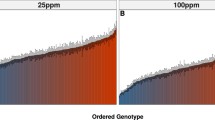Abstract.
Mutagenesis can be used as a means of predicting likely mechanisms of resistance to novel classes of insecticides. We used chemical mutagenesis in Drosophila to screen for mutants that had become resistant to imidacloprid, a neonicotinoid insecticide. Here we report the isolation of two new dominant imidacloprid-resistant mutants. By recombinational mapping we show that these map to the same location as Rst(2)DDT. Furthermore, we show that pre-existing Rst(2)DDT alleles in turn confer cross-resistance to imidacloprid. In order to localize the Rst(2)DDT gene more precisely, we mapped resistance to both DDT and imidacloprid with respect to P-element markers whose genomic location is known. By screening for recombinants between these P-elements and resistance we localized the gene between 48D5–6 and 48F3–6 on the polytene chromosome map. The genomic sequence in this interval shows a cluster of cytochrome P450 genes, one of which, Cyp6g1, is over-expressed in all resistant strains examined. We are now testing the hypothesis that resistance to both compounds is associated with over-expression of this P450 gene.
Similar content being viewed by others
Author information
Authors and Affiliations
Additional information
Electronic Publication
Rights and permissions
About this article
Cite this article
Daborn, .P., Boundy, .S., Yen, .J. et al. DDT resistance in Drosophila correlates with Cyp6g1 over-expression and confers cross-resistance to the neonicotinoid imidacloprid. Mol Gen Genomics 266, 556–563 (2001). https://doi.org/10.1007/s004380100531
Received:
Accepted:
Issue Date:
DOI: https://doi.org/10.1007/s004380100531




